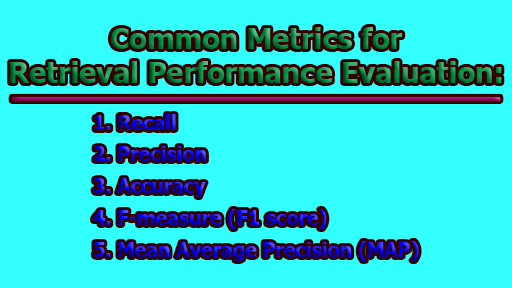Common Metrics for Retrieval Performance Evaluation:
Retrieval performance evaluation is a crucial aspect of information retrieval systems, which aims to assess the effectiveness of search algorithms in retrieving relevant documents from a given collection. The success of an information retrieval system heavily relies on its ability to provide accurate and relevant results to user queries. To measure and quantify this effectiveness, various metrics are employed. These metrics provide insights into different aspects of the retrieval process, such as the ability to retrieve relevant documents, precision in filtering irrelevant documents, overall accuracy, and a balanced combination of precision and recall. Here are some common metrics used for retrieval performance evaluation:
1. Recall: Recall is a fundamental metric used to evaluate the completeness of a classification or retrieval task, such as information retrieval systems. It quantifies the proportion of relevant documents retrieved correctly out of all the relevant documents available in the collection. High recall indicates a low false negative rate, meaning the system is effective in retrieving most of the relevant items, although it may also retrieve some irrelevant ones.
Formula:
The recall is calculated using the following formula:
Recall = Number of relevant documents retrieved / Total number of relevant documents in the collection
Example:
Let’s consider a document retrieval system that aims to retrieve research papers related to the topic of “Machine Learning.” The system is evaluated on a test dataset containing 50 relevant research papers related to machine learning, and there are 1000 research papers in the entire collection.
The system’s retrieval results are as follows:
- Total number of relevant documents retrieved by the system = 40
Out of the 50 relevant research papers available in the collection, the system managed to retrieve 40 of them (true positives). However, it missed retrieving 10 relevant papers (false negatives).
Using the above information, we can calculate the recall:
Recall = Number of relevant documents retrieved / Total number of relevant documents in the collection
= 40 / 50
= 0.8 or 80%
In this example, the recall of the information retrieval system is 80%. This means that out of all the relevant research papers available, the system successfully retrieved 80% of them. The high recall score indicates that the system is effective in capturing most of the relevant documents, which is crucial in ensuring that users have access to comprehensive and relevant information.
However, it’s important to keep in mind that high recall may come at the cost of lower precision, as the system may retrieve some irrelevant documents along with the relevant ones. Therefore, recall is often used in conjunction with other metrics like precision and the F-measure for a more comprehensive evaluation of the system’s performance.
2. Precision: Precision is a significant metric used to assess the accuracy of a classification or retrieval task, such as information retrieval systems. It quantifies the proportion of relevant documents retrieved correctly out of all the documents that the system retrieved. High precision indicates a low false positive rate, meaning the system is effective in identifying relevant items and minimizing irrelevant ones in the search results.
Formula:
The precision is calculated using the following formula:
Precision = Number of relevant documents retrieved / Total number of documents retrieved
Example:
Let’s consider a search engine designed to retrieve news articles related to the topic of “COVID-19.” The system is evaluated on a test dataset containing 50 documents, out of which 25 are relevant news articles related to COVID-19, and the remaining 25 are unrelated articles.
The system’s retrieval results are as follows:
- Total number of documents retrieved by the system = 20
Out of these 20 retrieved documents, let’s say 15 are actually relevant to COVID-19 (true positives), and the remaining 5 are irrelevant (false positives).
Using the above information, we can calculate the precision:
Precision = Number of relevant documents retrieved / Total number of documents retrieved
= 15 / 20
= 0.75 or 75%
In this example, the precision of the information retrieval system is 75%. This means that out of all the documents the system retrieved, 75% of them are actually relevant news articles about COVID-19. The high precision score indicates that the system is effective in identifying and retrieving relevant information, resulting in a relatively low number of irrelevant articles in the search results.
However, it’s essential to keep in mind that precision alone may not provide a complete picture of the system’s performance. For a more comprehensive evaluation, precision is often used in conjunction with other metrics like recall and the F-measure.
3. Accuracy: Accuracy is a fundamental metric used to evaluate the overall performance of classification tasks, including information retrieval systems. It measures the proportion of correctly classified documents (both relevant and non-relevant) out of all the documents in the collection. A high accuracy score indicates that the system is making accurate classifications, while a low score suggests that it is prone to misclassifications.
Formula:
The accuracy is calculated as follows:
Accuracy = (Number of true positives + Number of true negatives) / Total number of documents in the collection
Example:
Let’s consider a search engine designed to retrieve documents related to three different topics: Technology, Science, and History. The system is evaluated on a test dataset containing 100 documents, where 40 are Technology-related, 30 are Science-related, and 30 are History-related.
The system’s classification results are as follows:
a) Technology-related documents:
- True positives: The system correctly identifies 30 Technology-related documents.
- False positives: The system incorrectly classifies 5 Science-related documents and 2 History-related documents as Technology-related.
b) Science-related documents:
- True positives: The system correctly identifies 25 Science-related documents.
- False positives: The system incorrectly classifies 3 Technology-related documents and 2 History-related documents as Science-related.
c) History-related documents:
- True positives: The system correctly identifies 20 History-related documents.
- False positives: The system incorrectly classifies 4 Technology-related documents and 3 Science-related documents as History-related.
Using the above results, we can calculate the accuracy:
Total number of documents = 100
Number of true positives = 30 (Technology) + 25 (Science) + 20 (History) = 75
Number of true negatives = Total number of documents – Number of true positives = 100 – 75 = 25
Accuracy = (Number of true positives + Number of true negatives) / Total number of documents
= (75 + 25) / 100
= 100 / 100
= 1.0 or 100%
In this example, the accuracy of the information retrieval system is 100%. This indicates that the system made no misclassifications and correctly identified all the relevant documents for each topic. Such a high accuracy score demonstrates the effectiveness and reliability of the retrieval system in classifying documents accurately.
4. F-measure (F1 score): The F-measure, also known as the F1 score, is a popular metric used to evaluate the performance of information retrieval systems. It combines both precision and recall into a single score, providing a balanced assessment of the system’s effectiveness. The F1 score is particularly useful in situations where precision and recall have conflicting objectives.
Formula:
The F1 score is calculated as the harmonic mean of precision and recall, ranging from 0 to 1. It is defined by the following formula:
F1 score = (2 * Precision * Recall) / (Precision + Recall)
The F-measure ranges from 0 to 1, with 1 indicating perfect precision and recall, and 0 indicating no relevant documents were retrieved.
Example:
Let’s consider a binary classification problem for an email spam filter. The system’s task is to classify incoming emails as either “spam” or “not spam” (ham).
Suppose the filter is applied to a test dataset containing 100 emails, out of which 30 are actual spam (positive class) and 70 are legitimate (negative class) emails.
The system’s performance is evaluated as follows:
- The spam filter correctly identifies 20 out of the 30 actual spam emails (true positives).
- It mistakenly classifies 5 legitimate emails as spam (false positives).
- It correctly identifies 60 out of the 70 legitimate emails (true negatives).
- It mistakenly classifies 10 spam emails as legitimate (false negatives).
Based on these results, we can calculate precision and recall as follows:
Precision = True Positives / (True Positives + False Positives) = 20 / (20 + 5) = 20 / 25 = 0.8
Recall = True Positives / (True Positives + False Negatives) = 20 / (20 + 10) = 20 / 30 = 0.67
Now, let’s calculate the F1 score:
F1 score = (2 * Precision * Recall) / (Precision + Recall) = (2 * 0.8 * 0.67) / (0.8 + 0.67) ≈ 0.728
In this example, the F1 score of approximately 0.728 indicates a reasonable balance between precision and recall, signifying that the spam filter is effectively identifying spam emails while minimizing false positives and false negatives.
5. Mean Average Precision (MAP): Mean Average Precision (MAP) is a metric commonly used to evaluate the performance of information retrieval systems across multiple queries. It provides a comprehensive measure of the average precision over all possible recall levels, giving insights into how well the system performs across various queries.
Formula:
The MAP is calculated by taking the average of precision values at each relevant document position for each query and then computing the mean over all relevant queries. The formula for MAP is as follows:
MAP = (1/|Q|) * Σi=1 to |Q| (Σj=1 to Ri (Pj / j))
where:
- |Q| is the total number of queries.
- Σi=1 to |Q| represents the sum over all queries.
- Σj=1 to Ri represents the sum over all relevant documents for query i.
- Pj is the precision at the jth relevant document for query i.
Example: Consider an information retrieval system that retrieves documents for three different queries: Query A, Query B, and Query C.
- For Query A, there are 20 relevant documents, and the system correctly retrieves 12 of them. The precision at each relevant document position is as follows:
Precision = [1/1, 2/2, 3/3, 4/4, 5/5, 6/6, 7/7, 8/8, 9/9, 10/10, 11/11, 12/12] = [1.0, 1.0, 1.0, 1.0, 1.0, 1.0, 1.0, 1.0, 1.0, 1.0, 1.0, 1.0]
Average Precision for Query A = (1.0 + 1.0 + 1.0 + 1.0 + 1.0 + 1.0 + 1.0 + 1.0 + 1.0 + 1.0 + 1.0 + 1.0) / 12 = 1.0
- For Query B, there are 15 relevant documents, and the system correctly retrieves 9 of them. The precision at each relevant document position is as follows:
Precision = [1/1, 2/2, 3/3, 4/4, 5/5, 6/6, 7/7, 8/8, 9/9] = [1.0, 1.0, 1.0, 1.0, 1.0, 1.0, 1.0, 1.0, 1.0]
Average Precision for Query B = (1.0 + 1.0 + 1.0 + 1.0 + 1.0 + 1.0 + 1.0 + 1.0 + 1.0) / 9 ≈ 1.0
- For Query C, there are 10 relevant documents, and the system correctly retrieves 6 of them. The precision at each relevant document position is as follows:
Precision = [1/1, 2/2, 3/3, 4/4, 5/5, 6/6] = [1.0, 1.0, 1.0, 1.0, 1.0, 1.0]
Average Precision for Query C = (1.0 + 1.0 + 1.0 + 1.0 + 1.0 + 1.0) / 6 = 1.0
Now, let’s calculate the MAP:
MAP = (1/3) * (1.0 + 1.0 + 1.0) ≈ 1.0
In this example, the MAP of approximately 1.0 indicates that the information retrieval system performs exceptionally well across all three queries, with an average precision of 1.0 for each query.
At the end of the day, we can say that retrieval performance evaluation is critical for information retrieval systems, as it provides valuable insights into their effectiveness in retrieving relevant documents. By using metrics like Recall, Precision, Accuracy, F-measure, and Mean Average Precision (MAP), developers and researchers can measure the strengths and weaknesses of search algorithms, identify areas for improvement, and optimize the retrieval process to enhance user satisfaction. Employing these metrics in combination provides a comprehensive evaluation of the retrieval system, ensuring that it delivers accurate and relevant information to users.
References:
- Manning, C. D., Raghavan, P., & Schütze, H. (2008). “Introduction to Information Retrieval.” Cambridge University Press.
- Baeza-Yates, R., & Ribeiro-Neto, B. (2011). “Modern Information Retrieval.” Addison-Wesley.
- Salton, G., Wong, A., & Yang, C. S. (1975). “A Vector Space Model for Automatic Indexing.” Communications of the ACM, 18(11), 613-620.
- Voorhees, E. M., & Harman, D. K. (Eds.). (2005). “TREC: Experiment and Evaluation in Information Retrieval.” MIT Press.
- Zhai, C., & Massung, S. (2016). “Text Data Management and Analysis: A Practical Introduction to Information Retrieval and Text Mining.” Morgan & Claypool Publishers.
- Kishida, K., & Kando, N. (2005). “Information Retrieval Evaluation: TREC and CLIR.” Annual Review of Information Science and Technology, 39(1), 399-441.
- Webber, W., Moffat, A., & Zobel, J. (2010). “A similarity-based pooling method for entity ranking.” Information Retrieval, 13(4), 348-370.

Library Lecturer at Nurul Amin Degree College










